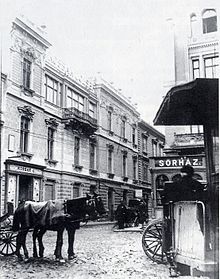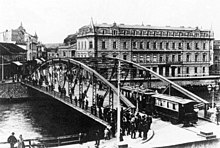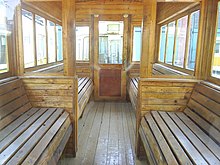Spiering car on the Timisoara tram
| Spiering car on the Timisoara tram | |
|---|---|
|
Four Spiering cars in the area of the city-side terminus on Piața Sfântul Gheorghe
|
|
| Number: | 21st |
| Manufacturer: | Kk state-authorized machine factory and vehicle construction company Johann Spiering |
| Year of construction (s): | 1869 |
| Gauge : | 1435 mm |
| Seats: | 16 |
The Spiering carriages of the Timișoara tram were a series of Hungarian horse-drawn carriages . The total of 21 vehicles manufactured by the Kk state-authorized machine factory and vehicle construction company Johann Spiering in Vienna , which had no company numbers, were procured by the then Temesvári Közúti Vaspálya Részvénytársaság (TeKöVa Rt.) In 1869 on the occasion of the opening of the local tram network . After electrification in 1899, ten of them were used as sidecars for the electric company until 1919 .
delivery
The Spiering wagons were transported from Vienna to the Banat as follows:
| five carriages on April 30, 1869 | for the opening of the Fabrikstädter line on July 8, 1869 = four round trips and a reserve car |
| six carriages on June 30, 1869 | for the opening of the Josefstadt line on October 25, 1869 = six circulations |
| four wagons on November 12, 1869 | in order to be able to double the four circuits of the factory town line |
| six carriages on December 27, 1869 | in order to be able to double the six rounds of the Josefstadt line |
Two horses were harnessed to each carriage, three when it was snowing. The first eleven cars cost 1755 each, the following ten cars each cost 1673 forints .
description
The compartment of a horse-drawn carriage was 4,300 millimeters long and 1,900 millimeters wide, and the cars had eight narrow windows on each side. The two open stages were each 770 millimeters long and 1260 millimeters wide, making the total length of a car 5840 millimeters. The wheelbase was also 1900 millimeters. The cars offered a total of 16 passengers seating on four longitudinal bench seats for four people each. As a special feature, the vehicles had two car classes until 1875 . The passenger compartment was divided in half, but the passage between the two compartments was open.
Further use as a sidecar after 1899
After the start of electrical operation on July 27, 1899, some of the Spiering cars were used as trailers on the main lines I and II behind the new Weitzer electric railcars . In order to be able to completely cover the six courses of line I and the four courses of line II, the tram company selected ten vehicles. It is not known which cars these were.
However, the sidecars were not used all the time, they only provided increased space during rush hour . Outside of these hours they were parked in certain places; for example, there was such a siding on the Piața Sfântul Gheorghe.
The cars have been modified accordingly for their new purpose. For example, they were given trumpet clutches . Furthermore, the kerosene lamps were replaced by electric lighting with incandescent lamps . According to another source, however, they were already electrically illuminated from July 12, 1889. It is not known whether the horse-drawn tram cars were also equipped with their own braking system for their new use .
The remaining 16 Spiering cars that were no longer needed, as well as the five Graz cars that were subsequently procured in 1891 , were decommissioned and scrapped on the occasion of electrification. The sidecars that remained in the inventory were given road numbers 1 to 10 in 1899; this involved double occupancy with the railcars.
Whereabouts
The sidecar operation in Timişoara initially ended on May 21, 1906, until 1909 only solo multiple units were temporarily in use. The reason for this was the use of new, larger type B railcars , the compression of line II and the linking of radial lines III and IV to form the new diameter line III. As a result, the Spiering wagons were parked, they were considered obsolete at the time and no longer adequate.
The passenger numbers, which rose sharply in those years, required reactivation as early as 1909, and in 1910 all ten of them were again included in the inventory. They were needed above all for excursion traffic on Sundays and public holidays in the summer months, while in the winters 1914/1915 and 1915/1916 they could be completely dispensed with. After the Spiering cars were initially supplemented by three new-build sidecars manufactured in 1914, 1915 and 1916 with the numbers 01 to 03 , the tram company was finally able to do without them from 1919. In its place, then came the first demotorisierten Weitzer motor coach and later as Type A , respectively.
The majority of the Spiering cars were scrapped, only one copy went to the Oradea tram after 1910 , where it also served as a trailer behind electric railcars. How long it was in action there is not known, and it has not been preserved either.
True to the original replica of a Spiering car from 1994
On the occasion of the 100th anniversary of the horse-drawn tram - 70 years of the electric tram in 1969, the tram company also wanted to present a horse-drawn tram to the audience of the anniversary parade at the time. Because none of the original horse-drawn passenger carriages had survived, a provisional solution was used: two AII sidecars with open platforms from 1921 were each harnessed to two horses.
In order to be able to show an authentic horse-drawn tram in the long run, the transport company decided on the occasion of the 125th anniversary in 1994 to recreate a horse-drawn tram in their own workshop based on the original plans from 1869. For this purpose, the last Weitzer railcar from 1899 was available, which was originally put into service as number 6 and was last used as a work car without a company number. Its undercarriage received a new structure, this replica bears - after the opening year of the horse-drawn tram - the fantasy number 1869. In 1996 the vehicle was briefly loaned to the Oradea tram. There the car was presented to the public for the 90th tram anniversary, although there was never a horse-drawn tram in Oradea itself.
Five years after its completion, the replica of the horse tram was extensively revised for the anniversary 130 years of the horse tram - 100 years of the electric tram for use in the anniversary parade, which took place on July 9, 1999. A few years later it was also repainted from green-dark green to yellow-orange.
See also
literature
- 60 de ani de la înființarea tramvaiului în Timișoara, monograph 1869-1929 . Timișoara 1929.
- Vasile Deheleanu, Sabin Indrieşu: Monografia întreprinderilor electromecanice municipale Timişoara . Timișoara 1944.
- Dorin Sarca, Gh. Radulovici: Centenarul tramvaielor din Timișoara, monograph 1869-1969 . Timișoara 1969.
- 1869 −1994, 125 de ani de circulație cu tramvaiul în Timișoara, monograph . Timișoara 1994.
- Regia Autonomă de Transport Timișoara, 130 de ani de activitate, 1869–1999, monograph . Timișoara 1999.
- Mihály Kubinszky , István Lovász and György Villány: Régi Magyar Villamosok . Budapest 1999.
Individual evidence
- ↑ a b c d Dorin Sarca, Gh. Radulovici: Centenarul tramvaielor din Timișoara, monograph 1869–1969 . Timișoara 1969.
- ^ Regia Autonomă de Transport Timișoara, 130 de ani de activitate, 1869–1999, monograph. Timișoara 1999.
- ↑ Tramvaiul cu cai din Timișoara (PDF; 993 kB)
- ↑ Allgemeine Deutsche Zeitung of November 21, 2009: The city has its new miracle - a giant lamp commemorates the 125th anniversary of Timisoara street lighting ( page no longer available , search in web archives ) Info: The link was automatically marked as defective. Please check the link according to the instructions and then remove this notice.
- ↑ A közlekedés és szállítás. A posta fejlődése on www.sulinet.hu, accessed on September 8, 2015
- ↑ The Oradea tram on www.eminescu.rdsor.ro ( Memento of the original from September 28, 2013 in the Internet Archive ) Info: The archive link was inserted automatically and has not yet been checked. Please check the original and archive link according to the instructions and then remove this notice.







